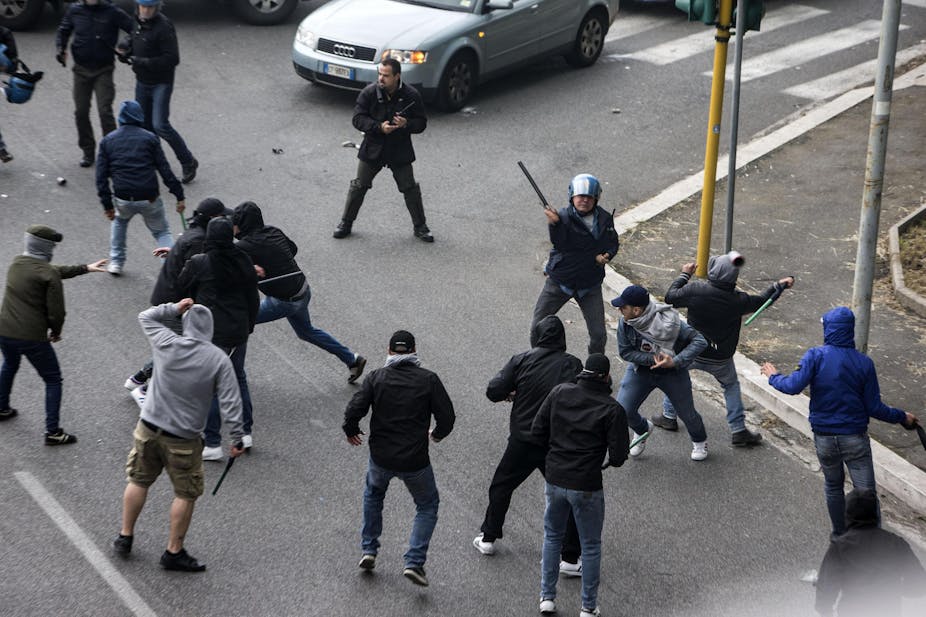The Italian Cup final has come to serve as a magnifying glass for Italian football’s worst problems. The 2014 final between Fiorentina and Napoli, marred by violence which left three people in hospital, tells its own story of how the game is being pushed towards crisis.
In the past, the Italian Cup final was played over two legs at the home stadiums of the finalists. But since 2008 it was reverted to a single match to be played at the Stadio Olimpico in Rome. The authorities wanted to make it a showcase event, similar in standing to the FA Cup in England. But giving the final a bigger stage has also highlighted the most dysfunctional sides of the game.
The final was delayed by 40 minutes after Napoli fans threw flares onto the pitch to cause confusion and protest to the authorities. The reason for the protest was that some of their fellow supporters had been injured in an altercation on the outskirts of Rome. Early reports were conflicting. Some suggested that there had been a nail bomb. It later transpired that three had been shot, one critically.
The situation wasn’t helped by further reports of violent clashes between Napoli and Fiorentina fans at an Autogrill service station on the outskirts of the city. The Napoli fans were concerned. In order to understand the violence, confusion and disruption, it is important to look at the wider context in Italian football, in particular, the role of the police, authorities and passionate fans called the ultras.
Part of the furniture
Flares have become a key part of the ultras’ matchday performance. They create the spectacle and atmosphere through choreography that include flags, banners, pyrotechnics and chanting. Ultras have been encouraged by presidents and politicians to create the matchday spectacle and have been offered free tickets and merchandising rights. This has given the leading ultras a prominent position in the game.

It is no coincidence that Marek Hamsik, the captain of Napoli, went to negotiate with the head of the Neapolitan ultras, Gennaro De Tommaso (nicknamed “Genny a carogna”, or “the swine”). Genny sported a T-shirt with the message “Free Speziale”; a reference to a Catania ultra who was convicted of killing the police officer Filippo Raciti in 2007. The image of the team captain negotiating with the head of the ultras to persuade them to stop delaying the match and allow the game to go ahead was extremely powerful.
These scenes were eerily reminiscent of the Rome derby between Roma and Lazio that was also held in the Stadio Olimpico in March 2004. Nicknamed “the derby of the dead child”, the match was halted after rumours circulated the stadium that the police had killed a child. Ultras of both sides united to stop the game and the captains of Lazio and Roma discussed the situation with the relevant heads of the ultras. In the end the referee suspended the match.
It is easy to blame the ultras for the problems that affect Italian football. These public displays of power disrupt games. It is true that some ultras engage in violence and this has led to state imposing ever more draconian measures and greater police attention. In February 2007 riots ensued after the Sicilian derby between Catania and Palermo led to the death of Raciti. The laws and policing, however, contribute to a strengthening of the ultras approach as they seek to reassert their identity and resist state repression.
Coming down hard
After the death of Raciti, the government imposed anti-terror legislation on all football fans. Stadiums had additional barriers erected outside so that fans would have to go through additional checks by security – all tickets had to have the supporter’s name imprinted on it which was then checked by stewards on entry. This was supposed to stop known violent fans from entering. The state also tried to impose a supporters’ identity card, the tessera del tifoso, on fans, yet this was successfully challenged. Genny the swine’s T-shirt highlighted how the ultras were uniting to resist state repression, overriding club rivalries.
The police also became more militarised. They already had a poor reputation amongst supporters and ultras. Aggressive policing helped create an anti-police mentality amongst fans, what Maurizio Stefanini calls “ACAB syndrome” after the English acronym for “All Cops Are Bastards”. Indeed, Valerio Marchi argued that the violent clashes between the police and fans of both sides before the “derby of the dead child” led to a situation where the fans believed the police had killed a child.
The problem with ever more draconian measures to control the excesses of the ultras is that it actually makes the problem worse. The measures affect all fans, not just the violent few. This results in fewer fans attending matches. As Contucci and Francesio argue in their book A Porte Chiuse, “They want to expel the violent from the stadium. They have expelled everyone except the violent.”
This reinforces the ultras as the “authentic” fans, and emboldens them to resist all authority. When situations occur, such as in the final in Rome, then the ultras feel that they need to stand up for their comrades in the face of police and state repression.

